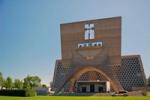Last week, I was lucky enough to attend a 70mm preview screening of The Brutalist at the BFI Southbank.
I first caught a glimpse of The Brutalist a few months ago during a trailer. At first, I assumed it was a documentary, having recently seen a film about Elliot Noyes. It wasn’t until the buzz around the film began to build that I realised it was a work of fiction.
The film was apparently shot in VistaVision, first introduced in the 1950s, where 35mm film is run horizontally rather than vertically. Instead of exposing two simultaneous four-perforation frames, the entire eight perforations are used for a single frame As someone who regularly attends digital screenings, I was curious to see how much of a difference the format would make. The best way I can describe it is like being at the optometrist, wearing those funny glasses while they switch between different lenses, asking, ‘Is it better like this or like this, like this or like this?’. Then, suddenly, the right lens clicks into place, bringing everything into focus. I have astigmatism and I’m short-sighted — so my analogy might only make sense to others with a similar affliction. It’s not that everything was simply sharper; it had a crisper depth of field, vivid colours and a tactile quality. The flickering of the 70mm projector, combined with the knowledge that someone was operating this massive piece of machinery, evoked 1950s cinema, and its rich colours perfectly complement the film’s portrayal of postwar America.




